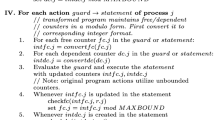Summary
Astabilizing system is one which if started at any state is guaranteed to reach a state after which the system cannot deviate from its intended specification. In this paper, we propose a new variation of this notion, called pseudo-stabilization. Apseudo-stabilizing system is one which if started at any state is guaranteed to reach a state after which the system does not deriate from its intended specification. Thus, the difference between the two notions comes down to the difference between “cannot” and “does not” — a difference that hardly matters in many practical situations. As it happens, a number of well-known systems, for example the alternating-bit protocol, are pseudo-stabilizing but not stabilizing. We conclude that one should not try to make any such system stabilizing, especially if stabilization comes at a high price.
Similar content being viewed by others
References
Afek Y, Brown G: Self-stabilization of the alternating-bit protocol. In: xx (ed) Proc 8th Symp on Reliable Distributed System, pp 80–83, 1989
Bastani F, Yen I, Chen I: Class of inherently fault-tolerant distributed programs. IEEE Trans Software Eng 14(10): 1432–1442 (1988)
Brown G, Gouda M, Wu C: Token systems that self-stabilize. IEEE Trans Comput 36(6):845–852 (1989)
Burns J, Pachl J: Uniform self-stabilizing rings. ACM Trans Program Lang Syst 11(2):330–344 (1989)
Dijstra EW: EWD 391, Self-stabilization in spite of distributed control (1973) Reprinted in: xx (eded) Selected writings on computing: a personal perspective, Springer, Berlin Heidelberg New York, 1982, pp 41–46
Dijkstra EW: Self-stabilizating systems in spite of distributed control. Commun ACM 17:643–644 (1974)
Gouda M, Evangelist M: Convergence/response tradeoffs in concurrent systems. Tech Rep TR-88-39, Dept of Computer Sciences, University of Texas at Austin, 1988 (also being revised for the ACM Trans Comput Syst Lang, 1989)
Gouda M, Multari N: Stabilizing communication protocols. IEEE Trans Comput 40(4):448–458 (1991)
Gouda M, Howell R, Rosier L: The instability of selfstabilization. Act Inf 27:697–724 (1990)
Katz S, Perry K: Self-stabilizating extensions for message passing systems. MCC workshop on Self-stabilization, August 1988
Lamport L: The mutual exclusion problem: Part II-statement and solutions. J ACM 33:327–348 (1986)
Multari N: Towards a theory for self-stabiling protocols. Ph.D. dissertation, Dept of Computer Sciences, University of Texas at Austin, 1989
Stalling W: Data and Computer Communications. Macmillan, 1985, pp 133–140
Author information
Authors and Affiliations
Additional information
James E. Burns received the B.S. degree in mathematics from the California Institute of Technology, the M.B.I.S. degree from Georgia State University, and the M.S. and Ph.D. degrees in information and computer science from the Georgia Institute of Technology. He is currently an Associate Professor in the College of Computing at the Georgia Institute of Technology, having served previously on the faculty at Indiana University. He has broad research in theoretical issues of distributed and parallel computing, especially relating to problems of synchronization and fault tolerance.
Mohamed Gawdat Gouda was born and raised in Egypt. His first bachelor degree was in engineering, and his second was in mathematics. Both degrees are from Cairo University. After his graduation, he moved to Canada where he obtained an MA in mathematics from York University, and a Master and a Ph.D. in computing science from the University of Waterloo. Later, he moved to the United states of America where he worked for the Honeywell Corporate Technology Center for three years. In 1980, he moved to the University of Texas at Austin, and has settled there ever since, except for one summer at Bell Labs, one summer at MCC, and one winter at the Eindhoven Technical University. Gouda currently holds the Mike A. Myer Centennial Professorship in Computing Science at the University of Texas at Austin. Gouda's area of research is distributed and concurrent computing. In this area, he has been working on: abstraction, nondeterminism, atomicity, convergence, stability, formality, correctness, efficiency, scientific elegance, and technical beauty (not necesarily in that order). Gouda was the founding Editor-in-Chief of the journal Distributed Computing, published by Springer-Verlag in 1985. He was the program committee chairman of the 1989 SIGCOMM Conference sponsored by ACM. He was the first program committee chairman for the International Conference on Network Protocols, established by the IEEE Computer Society in 1993. Gouda is an original member of the Austin Tuesday Afternoon Club. In his spare time, he likes to design network protocols and prove them correct for fun.
Raymond E. Miller received his Ph.D. in 1957 from the University of Illinois, Champaign-Urbana. He was a Research Staff Member at IBM, Thomas J. Watson Research Center, Yorktown Heights, N.Y., from 1957 until 1980, Director of the School of Information and Computer Science at Georgia Tech from 1980 until 1987, and is currently a professor of computer science at the University of Maryland, College Park and Director of the NASA Center of Excellence in Space Data and Information Sciences at Goddard Space Flight Center. He has written over 90 technical papers in areas of theory of computation, machine organization, parellel computation and communication protocols. He is a Fellow of the IEEE and a Fellow of the American Association for the Advancement of Science. He has been active in the ACM and IEE/CS, and is a Board member of the Computing Research Association. In the IEEE/CS, he is a member of the Board of Governors and the 1991 Vice President for Educational Activities.
Rights and permissions
About this article
Cite this article
Burns, J.E., Gouda, M.G. & Miller, R.E. Stabilization and pseudo-stabilization. Distrib Comput 7, 35–42 (1993). https://doi.org/10.1007/BF02278854
Received:
Accepted:
Issue Date:
DOI: https://doi.org/10.1007/BF02278854




